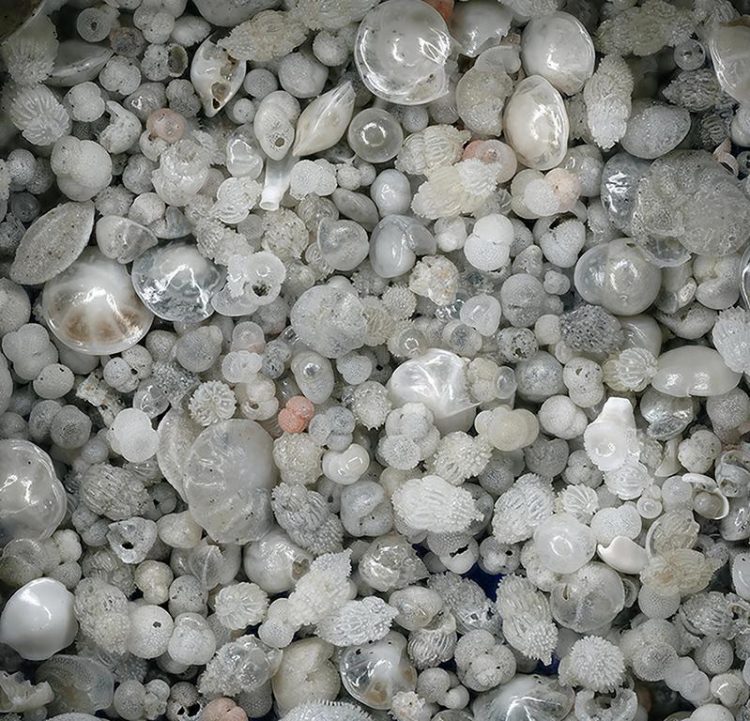An international team including scientists from MARUM discovered ongoing and future tropical diversity decline

Shells of planktonic foraminifera from ice-age sediments in the Atlantic Ocean. Fossils like these were used in this study to reveal that global warming may lead to decline in tropical marine biodiversity. (Photo: MARUM – Center for Marine Environmental Sciences at the University of Bremen)
The research, published in Proceedings of the National Academy of Sciences (PNAS), used fossils to reconstruct global oceanic biodiversity patterns for the last ice age (approximately 20,000 years ago) and the pre-industrial period, i.e. before 1950, and used the results to make projections for the near future (2090s).
The equatorial “dip” in diversity that is observed today existed already during the pre-industrial period but it was not present during the last ice age. The decline of tropical diversity is the result of warming after the ice age, and it appears that anthropogenic warming will worsen the tropical diversity decline further.
By the end of the 21st century, tropical diversity may decrease to levels not seen for millions of years if our future aligns with the “business-as-usual” CO2 emission scenario.
The pelagic ocean covers the vast majority of Earth’s surface and is the largest biome on Earth. It is home to phytoplankton that play a key role in global oxygen production, top predators and economically important species that are increasingly under threat from climate change.
To reconstruct the past state of tropical marine diversity, the researchers used tiny shells of fossil plankton called foraminifera. These shells are preserved in marine sediments and act as sentinels of changes in past pelagic ecosystems.
“Biodiversity is usually high in the tropics and low at the poles. We call this important pattern the ‘latitudinal diversity gradient’. Yet, recent studies have found that global marine biodiversity patterns often show an equatorial 'dip' of diversity. We wanted to explore what caused this, and whether it was a recent pattern,” says lead author Moriaki Yasuhara from the University of Hong Kong (China).
“These clear links between warming and reduced tropical biodiversity mean that by the end of this century oceanic diversity at the equator may dip to a level unprecedented in human history,” co-author Derek P. Tittensor, associate professor at Dalhousie University, concluded.
“This research shows furthermore how data on past marine ecosystems preserved in marine sediments provide scenarios of diversity change relevant to the assessment of global change policies,” adds co-author Michal Kucera from MARUM.
Prof Michal Kucera
MARUM working group Micropaleontology – Paleoceanography
Phone: +49 421 21865970
Email: mkucera@marum.de
Moriaki Yasuhara, Chih-Lin Wei, Michal Kucera, Mark J. Costello, Derek P. Tittensor, Wolfgang Kiessling, Timothy C. Bonebrake, Clay Tabor, Ran Feng, Andrés Baselga, Kerstin Kretschmer, Buntarou Kusumoto, and Yasuhiro Kubota (2020): Past and future decline of tropical pelagic biodiversity. Proceedings of the National Academy of Sciences of the United States of America. DOI: 10.1073/pnas.1916923117
https://www.marum.de/en/Discover/An-international-team-including-scientists-from…
Media Contact
All latest news from the category: Earth Sciences
Earth Sciences (also referred to as Geosciences), which deals with basic issues surrounding our planet, plays a vital role in the area of energy and raw materials supply.
Earth Sciences comprises subjects such as geology, geography, geological informatics, paleontology, mineralogy, petrography, crystallography, geophysics, geodesy, glaciology, cartography, photogrammetry, meteorology and seismology, early-warning systems, earthquake research and polar research.
Newest articles

Magnetic Effect: Groundbreaking Discovery for Low-Temperature Thermoelectric Cooling
Researchers at the Max Planck Institute for Chemical Physics of Solids, in collaboration with Chongqing University and the Max Planck Institute of Microstructure Physics, have achieved a breakthrough in topological…

Parallel Paths: Understanding Malaria Resistance in Chimpanzees and Humans
The closest relatives of humans adapt genetically to habitats and infections Survival of the Fittest: Genetic Adaptations Uncovered in Chimpanzees Görlitz, 10.01.2025. Chimpanzees have genetic adaptations that help them survive…

You are What You Eat—Stanford Study Links Fiber to Anti-Cancer Gene Modulation
The Fiber Gap: A Growing Concern in American Diets Fiber is well known to be an important part of a healthy diet, yet less than 10% of Americans eat the minimum recommended…



